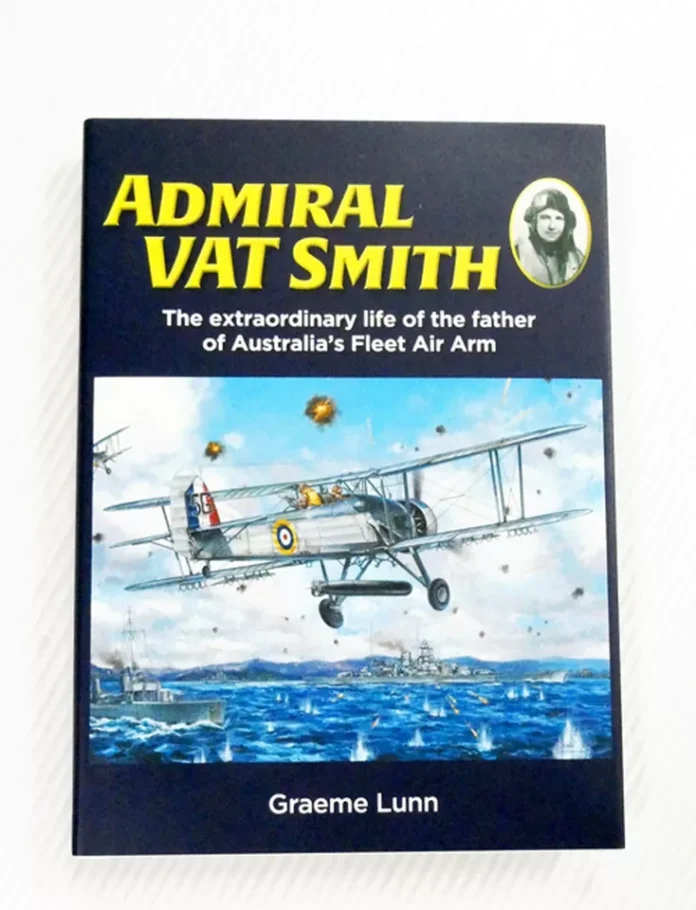
Admiral VAT Smith: The extraordinary life of the father of Australia’s Fleet Air Arm. By Graeme Lunn. Avonmore Books, Kent Town, 2024.
Reviewed by Peter Jones
There is a considerable backstory to this long awaited and fine biography of Admiral Sir Victor Alfred Trumper Smith. In 1991 the 78-year-old Admiral Smith was the RAN’s most consequential living admiral. Not only had ‘VAT’ played a pivotal role in the creation of the Fleet Air Arm, his wartime exploits included leading a Swordfish strike against the German battle cruiser Scharnhorst, being shot down twice and surviving the sinkings of the aircraft carrier Ark Royal and the cruiser Canberra.
Post war he was the Executive Officer of the aircraft carrier Sydney during her notable Korean War deployment. The ship would win the Duke of Gloucester Cup for the most efficient ship in the Fleet. He went on to command two frigates, as well as the aircraft carrier Melbourne, all of which earned the Gloucester Cup. His final appointments were Chief of Naval Staff and Chairman of the Chiefs of Staff Committee during quite eventful periods. In 1991 the Chief of Naval Staff was initially Vice Admiral Mike Hudson and then Vice Admiral Ian MacDougall. Both resolved, to ensure that Smith’s recollections were captured before it was too late.
The challenge was to find someone suitable to approach VAT with the proposal and then to conduct the interviews. VAT could be intimidating, due to mantle he had been placed and his at times austere presence. Otherwise outgoing and extroverted ‘birdies’ could go into their shells in the presence of the great man. The person chosen for this assignment – Commodore ‘Toz’ Dadswell – had served under VAT on a number of occasions. Importantly, Toz had himself an impressive flying record, was acceptable to VAT and knew where all the skeletons were buried. Once VAT agreed, after first rebuffing the idea, a series of interviews over several months were conducted. Toz, assisted by CNS’ staff, worked with VAT in refining the draft and producing the memoir with the financial assistance of the Australian Naval Institute. It remains the only book published by the ANI. The memoir was launched at the National Press Club in April 1992 by Vice Admiral MacDougall in the presence of VAT as well as CINCPACFLT and fellow naval aviator, Admiral Robert Kelly. Some Memories of Sir Victor Smith. (can be downloaded at https://navalinstitute.com.au/wp-content/uploads/A-Few-Memories-of-Sir-Victor-Smith-2-copy.pdf.
There was, however, one shortcoming with the project – VAT was modest and reticent to a fault. It was clear at the time that VAT clearly warranted a biography to put his life into proper perspective. Some Memories at least provided some key material in the form of VAT’s own voice for a future biographer.
Fast forward 32 years and former naval aviator and seaman officer Graeme Lunn has fulfilled that long held aspiration most admirably. It should also be noted that ANI Councillor Desmond Woods previously undertook valuable scholarship into VAT Smith’s career, both for his Australian Dictionary of Biography entry and more recently in the VAT Smith chapter in the forthcoming The Navy Chiefs: Australia’s naval leaders, 1911 – 1997.
Graeme Lunn has approached his task in a very thorough manner and accessed Australian, UK and US archives as well as various personal papers. The resultant biography is a clear and flowing read that takes pains to explain the broader political or social context where required. It also makes naval administration and operations of the day understandable to the lay reader, as well as the modern sailor.
Importantly, although Graeme Lunn clearly admires VAT, the book is not hagiography. While the book’s title talks about “the extraordinary life”, his biographer points out for much of VAT’s early career, he was ordinary. Yet through circumstance, valour, common sense, professional competence and determination, VAT was to become an admiral of considerable significance to the Navy and the Australian Defence Force. Graeme Lunn does include incidents that may not lead the reader to warm to VAT. But they do illustrate the complexity of the man, as well as how much times have changed.
A particular strength of the book is Lunn’s description of VAT’s flying career. Its pre-war descriptions of naval aviation give a flavour of its fledgling nature and is reminiscent in that regard of Thomas Wildenberg’s biography of Admiral Joseph Reeves’ All the Factors of Victory. Importantly, Grame Lunn also provides a very good account and assessment of VAT as a warship commanding officer.
Less extensive is Lunn’s coverage of VAT’s years as Chairman Chiefs of Staff Committee. As he will explain in a forthcoming article in the Australian Naval Review, the material to work from was less extensive. In addition, VAT, perhaps mindful of the controversy surrounding the Tange Review, remained tight-lipped on this period of his long career.
Avonmore has earned a fine reputation for the quality of their predominantly aviation books. Physically, Admiral VAT Smith is a handsome full colour book and is profusely illustrated with over 180 photographs. They are not just of people, ships and aircraft, but of Smith’s memorabilia. All this makes for a first-class biography for anyone with an interest in our Navy or naval aviation.



